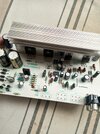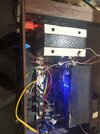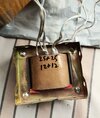Your sub may be...
1) vibrating internally due to the high base volume (heavy components like large capacitors, inductors or mounting hardware (even wires or cord restraints) can be vibrating. Hot glue seems to work well without causing problems with the components. Also, check your speakers. A strong bass amplifier can cause screws to pull out of a particle board cabinet and allow the speaker to vibrate.
2) bass frequencies take a lot (A LOT) of power. Your power supply may not be up to the task for the volumes you are trying to use. A weak power supply may output lower and lower voltage as your bass amplifier draws more amperes. At some point the amplifier is trying amplify and output a voltage that is greater than the input. This causes an output wave to be "clipped" and sound buzzy.
If you have a 3amp 12v supply, for example, you could try a 10amp, 12v supply. Or some other higher amperage power supply at whatever your operating voltage may be.
There are other causes, mechanical vibrations and signal clipping but let's start with those.
Others may be oscillating amplifier, ground loops and other electrical interference or resonances from your crossover (for example).




